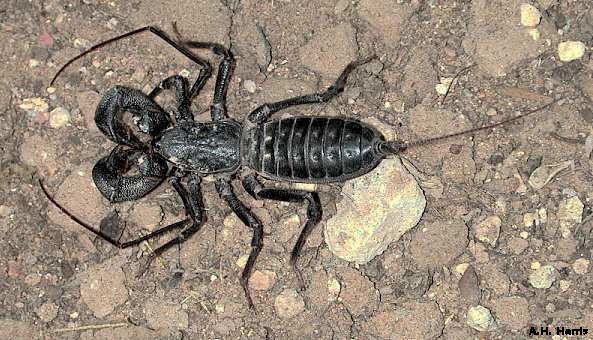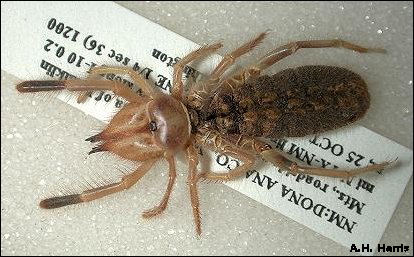
There are a few broadly recognized symbols of the desert: sand dunes, saguaros, rattlesnakes, and scorpions. Scorpions and related forms, including spiders, pseudoscorpions, daddy longlegs, and solpugids, do well in the desert as do the more distantly related centipedes and millipedes.
Depending on the classification used, the Myriapoda may be considered a subphylum or a class. The centipedes and millipedes belong to this taxon; again, depending on the classification used, they may be considered as classes (Chilopoda, Diplopoda) or orders within the class Myriapoda.
Some idea of the variation within the Diplopoda can be seen at the Kendall Bioresearch Services website, as can information regarding centipedes. Information specifically on desert centipedes and millipedes is given at the Arizona-Sonoran Desert Museum site. Millipedes are considered harmless if somewhat stinky when disturbed; centipedes have a pair of claw-like structures under the head that have poison. The larger of our desert centipedes may give painful bites but are not considered dangerous to humans. A picture of the poison claws can be seen on the Kendall centipede site.
The class Arachnida of this subphylum includes a number of orders. The ones we'll consider here are the orders Araneae (spiders), Pseudoscorpionida (book scorpions, false scorpions, and pseudoscorpions), Scorpiones (scorpions), and Solpugida, also known as Solifugae (solpugids and sun spiders), and the Uropygi (vinegaroon). There are other chelicerates in the Chihuahuan Desert not covered here.
Spiders are common in the desert. All are venomous, but relatively few are dangerous to humans. Among these are members of the genus Loxosceles, which includes the Brown Recluse Spider and several others of similar appearance. Widow Spiders (Lactrodectes hesperus), the western equivalent of the Black Widow Spider, is common throughout our area, especially in urban areas. Tarantulas probably are considered by most to be the spider of the deserts. Although popular mythology has them as being deadly, tarantulas, like most spiders, are slow to bite. Although a bite may be painful, the venom is not considered dangerous to humans.
The pseudoscorpions are an inconspicuous group with probable minimal impact on the environment, but are an interesting group widespread throughout much of the world.
The scorpions are an important group in the Chihuahuan Desert, as well as in arid regions elsewhere in the world. A number of species occur in a variety of habitats. Most species can give a painful sting, but few are really dangerous. The dangerous ones are not those that most people would pick as such; instead of relatively large species, the small Centruroides is the danger. A technical article, Scorpion Envenomations, gives more information on scorpion stings.
Vinegaroons (also known as whip scorpions) are common inhabitants of the desert and often brought in for identification. Many desert residents assume they are poisonous, but other than being able to give a hearty pinch and a spray of acetic acid (otherwise known as vinegar), they are harmless, and unless they feel threatened, can be handled with care.

A Vinegaroon from El Paso. Photograph of a captive individual by A.H. Harris.

A preserved specimen from southern New Mexico. Photograph by A.H. Harris.
Solpugids, often call sun spiders, are widespread in western North America and in many other parts of the world. Although they look formidable, they are basically harmless to humans, and some people allow them to remain in a residence to help keep down insect vermin.